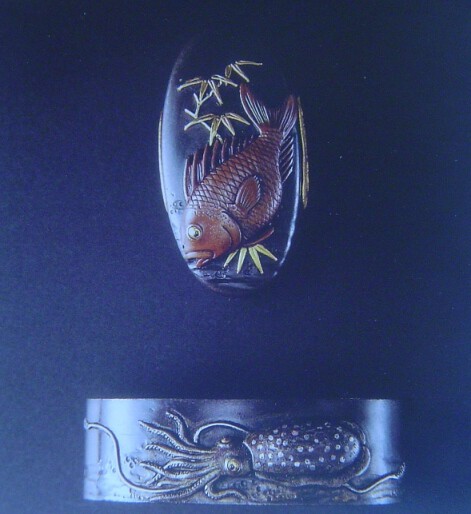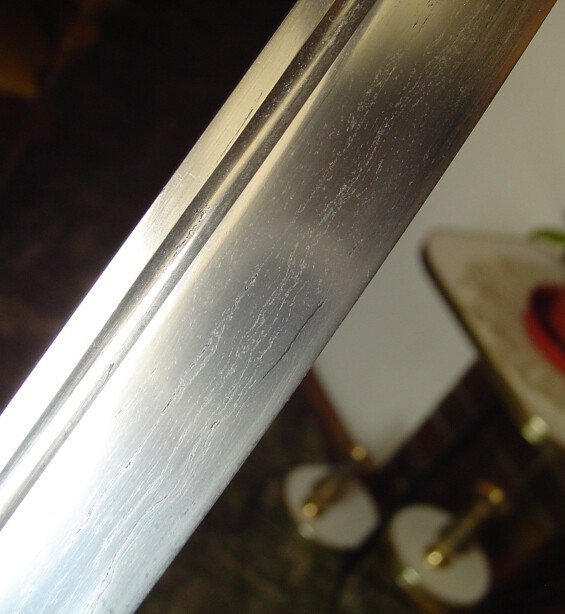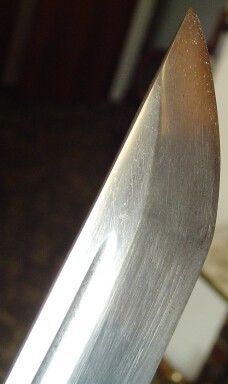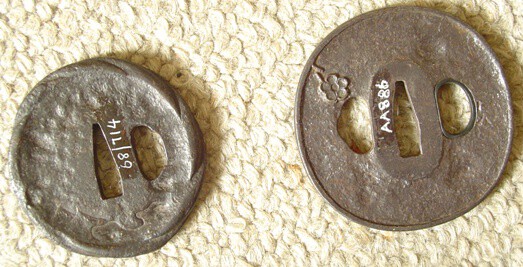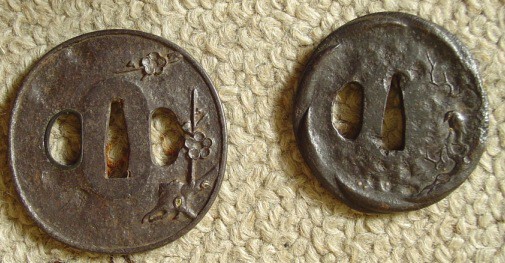
Nostro Titus
Members-
Posts
23 -
Joined
-
Last visited
Content Type
Profiles
Forums
Events
Store
Downloads
Gallery
Everything posted by Nostro Titus
-
Thanks for the helpful input, guys. Regarding the restoration, I'm leaving any cleaning and restoration to the experts. I would like to see the end result though. Marius
-
Thanks for the rapid responses. I will relate the options to him. Marius
-
Good day I recently handled these two. Both unfortunately were sanded and coated with black enamel paint and then suffered more rusting. The fuchi depicts chery blossoms (mostly the half of the blossoms, unfortunately no sign of the matching saya guchi). Would the tsuba be Higo work (I was tempted to say Akasaka but in the end the overall look and finish pulled me towards Higo). Any information and comments welcome. Marius
-
Good day A gentleman asked me to validate this sword and is now interested in having it polished. Unfortunately all activities are obscured and there are some nasty areas where the kawagane is worn through. He is open to polishers based in Japan as well as Britain, but Britain would be more convenient for him. I have included some pictures of the blade just to show the general state it is in. It appears to be mumei shinto (please feel free to correct if wrong) with slightly extended kissaki. There are hints of masame in the boshi as well as at some spots in the ji, at one spot with large mokume present as well. yasurime that are left (someone did some heavy sanding in places) are kiri. Motokasane is 6.3mm just before the abrupt thinning in front of the machi, motohaba: 27mm. nagasa: 69.3cm Keep well Marius
-
Firstly, this thread ranks among the more informative and insightful. From my side there isn't much more to add, only the following. The mountings, including tsuba were made in a cultural environment that in many ways differ from the world today. Tsuba from the Muromachi and Edo already show signs of a different approach in subject matter and methods of execution and materials used. It would seem natural that contemporary tsuba would differ from their historical counterparts as they are made by artists that are trying to express themselves within the context of their culture and personal experience. The historical tsuba would have been something fresh and new, adding accent to the mountings and uniform. Like all things new, eventually the novelty wears off, it becomes a norm and loses some of the strength of expression. There are exceptions to this rule obviously. There is nothing wrong in the copying of historical pieces in order to gain a deeper understanding of the mindset and techniques of the historical artist, but even then there will be a bit of the copier expressed in the workpiece due to his interpretation of the item copied. My opinion is that there will always be a place for modern tsuba and that they will mostly be judged by the way the artist reflects his ideas (and school of thought) within his current environment, something that a blind copy or cast replica will lack. Regarding the functionality of tsuba and the protection of hand theory (incidentally, has anyone ever thought about it acting as a marker when you draw the sword, pretty much saying 'grip stops here, scabbard starts below', just a personal hypothesis). I am not in a position to comment on the Japanese sword in martial usage, but as I am heavily involved in the teaching of European swordsmanship a close parallel was the cross protecting the hand theory. In reality the instance of a blow striking the cross is very rare (there are situations where it is actively used in offense or defense). It does however serve a a good barrier when your wrist or hand is attacked by someone not stepping offline. I am guessing that the tsuba would be helpful in such a situation , whether by design or convenient coincidence. Trained people tend to step offline to cut to the hands and arms, completely bypassing the cross though. (I should leave this bit for the actual Japanese sword-art practitioners, I believe that includes Ford?). That aside, in the end as long as there are artists producing unique workpieces regardless of their area of specialization in style or materials, there will be people interested in the pieces because something in it piques their interest or resonates with their perception of art. A given item can mean many things to many people, that tells us more about the collector though and not the artist. In essence some people judge art the same way they judge people, seniority and age counts. Just my humble bit. Marius
-
Jacques The more I look at the oshigata the more your statement seems to be the case. If it is in any way helpful, here are the statistics: Total length 92cm/ nagasa:70cm/ nakago:22cm motohaba:31.2mm/ motokasane:6.5mm/ sakihaba:20.1mm/ sakikasane:4.8mm Width of the ji at the machi:20.1mm/ width of shinogiji:9.55mm The blade's shinogi is pefectly level with the thickness at the mune. Thanks for your input Marius
-
Hi Brian The nakago is only 22cm long, that is what made me consider suriage rather than machi-okuri. Marius
-
Here are a few more pictures of the sword in question. The hada is only visible in one spot protected by the habaki. The is a bit of weak ayasugi just under the shinogi but I'm strugling to see good masame that would help sugest Mino influence. The shinogi is no raised at all. Hopefully the picture shows the proportion of the kissaki (it has a notare komi boshi with very short ko-maru turnback on one side, can't see on the other. Hamon is nioi deki with sporadic nie scattered
-
Thanks Ludolf.
-
Hi I know I've been dodging the radar for a while lately, getting quite good at it apparently :D Does anyone have any example oshigata of Kanenori that moved from Mino to Echizen around 1573. He normally signed Echizen no Kuni ju Kanenori. Thanks Marius
-
Unfortunately there are no pictures of the blade including the nakago since I was simply called in to redo the damaged ito and had no time to have a look at the nakago. It is still on exhibition at the Jewish museum in Cape town.
-
I thought I would share a few pictures of a tanto. It is unsigned, attibuted as being Rai school. Enjoy.
-
Another tsuba. I actually enjoy the simple yet elegant design. Anyone willing to have a go at this one?
-
Thanks for the quick reply, Ford.
-
Hi. Just thought I would share this tsuba. Unfortunately it met someone intent on cleaning the "rusty iron" but at least it's not as bad as another one I saw. Does anyone have an idea as to the manufacturer of this piece? Nostro
-
The following picture is of a late 19th century naginata of which the nakago was simply left as it was forged, complete with oxidation from the forge as well as a few hammer marks. The end of the nakago has been broken off, resulting in a rough end. Some rough filing was done to accept the habaki. Up to this point this is the first and only case I have encountered thus far. Has anyone else run into this? Even for a quick low cost production blade I thought that nakago were at least cleaned. Regarding the blade, it has crudely carved naginata-bi and large notare hamon (it is in too bad a state to see more than that unfortunately). Nostro
-
Thanks Brian. There is a copy in one of my favourite hide-aways (Cultural history museum Library). I assumed it is no longer available, will go a-hunting now. Nostro
-
I'm not an armour collector (yet ), but had to do a lot of research regarding the construction and development of Japanese armour. I would be all for a forum for armour discussion. That way I can finally be educated further by the real armour gurus. Nostro
-
-
Hi all. I have been wondering about this one for a while. It has a nagasa of 45cm, kasane of 5.5mm, relatively low shinogi, low iori-mune and the thickness of the nakago pinches in quite visible at the habakimoto. It's surface was badly scuffed but hamon is a very narrow suguba(apparently due to a lot of polishing since it has lost it's shape at the area above the hamachi) and no nie are visible, so it seems to be in nioi deki. The boshi is completely obscured and the area just above the mei is slightly depressed and covered with haphazard file marks not conforming with the yasurime. The grain seems quite rough with many slag inclusions. For the moment I was tempted to say kazu-uchimono but also Kanabo school (in A connasseur's guide to Japanese swords their word was described as having relatively low shinogi but other sources differ on that point). Anyone willing to steer me in the right direction? Nostro
-
Here are two nice iron tsuba (both unsigned and input would be helpfull) that I thought I'd share. Nostro
-
Thanks for that. One thing listed in another WM Hawley text is 'surume gitae' (squid forging). It was defined as steel being folded like a cooked squid. Anyway, time to start digging deeper into the literature. Nostro
-
Hi all. I just thought i'd start out with a few questions. Regarding the various construction methods (kobuse gitae, honsanmai etc.), are there any sources in literature that specify which traditions and schools used which. Related to this, I always wondered why many Mino Seki blades seemed to have masame in the shinogi ji and mokume in the ji and this pretty much ties in with the first question. Any comments on how polishers contributed to this knowledge is also very welcome. Thanks in advance, Nostro

